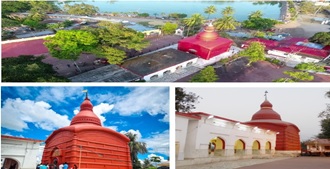23 September, 2025
Inauguration of Ancient Tripura Sundari Temple
Wed 24 Sep, 2025
Reference
- Prime Minister Narendra Modi inaugurated the redeveloped complex of the 524-year-old Tripura Sundari Temple located in Udaipur, Gomati District, Tripura.
Key Points
- The temple is one of the 51 Shakti Peethas in India and holds immense religious and cultural significance.
- The site was redeveloped under the Pilgrimage Rejuvenation and Spiritual, Heritage Augmentation Drive (PRASHAD).
Development Work and Cost
- Total Cost: Approximately ₹34.43 crore
- The project upgraded facilities, connectivity, and infrastructure while preserving the sacred Shakti Peeth.
- Surrounding areas were modernized with contemporary amenities without compromising historical and religious importance.
Project Initiation and Expansion
- Approved in FY 2020-21 at a cost of ₹34.43 crore.
- 54 projects initiated across 28 states/UTs.
- Major pilgrimage and heritage sites are being enhanced with world-class facilities.
Objective and Significance
- Reflect Prime Minister Modi’s vision of “Vikas Bhi, Virasat Bhi” (Development with Heritage).
- The PRASHAD scheme integrates heritage conservation with development.
- Aims to make North-East India a hub of spiritual tourism.
Tripura Sundari Temple Details
- Other Names: Tripureshwari Temple, Matabari
- Constructed By: Maharaja Dhanya Manikya of Tripura in 1501
- Main Deity: Goddess Tripura Sundari, worshipped as a Shakti Peeth
- Location: Hilly area near Bangao, West Tripura district, about 55 km from Agartala
Religious and Cultural Significance
- Considered one of India’s 51 Shakti Peethas, where a part of Goddess Sati’s body is believed to have fallen.
- Goddess Tripura Sundari is revered as the goddess of power and beauty.
- The temple is a cultural and religious center with Tantric practices.
- Major festivals: Tripura Sundari Jayanti, Durga Puja, and Navratri are celebrated with grandeur.
Architecture and History
- The temple blends Hindu craftsmanship and local architectural styles.
- Built on a turtle-back shaped hill called ‘Kurva Peeth’.
- Notable features: The main idol (Maa) and Chhoto Maa (small idol).
Redevelopment (Under PRASHAD Scheme)
- Cost: ₹52 crore (Central Government), Tripura Government contributed ₹7 crore.
- Redevelopment includes: Beautification of temple complex, new entrance, marble flooring, drainage system, food stalls, meditation hall, guest accommodations, administrative office, and drinking water facilities.
- Goal: Make the temple a center for spiritual tourism, boosting local industry, employment, and cultural revival.
Accessibility and Transport
- Located about 55 km from Agartala by road.
- Nearest railway station and airport are also in Agartala.
Socio-Economic Impact
- Expected to boost religious tourism, supporting local economy.
- Growth of tourism-related businesses: hotels, transport, handicrafts, etc.
- Redevelopment preserves religious sanctity while promoting regional cultural heritage.
PRASHAD (Pilgrimage Rejuvenation and Spiritual Heritage Augmentation Drive) Scheme
Overview
- Full Name: Pilgrimage Rejuvenation and Spiritual, Heritage Augmentation Drive (PRASHAD)
- Launched: 2014-15 by the Government of India
- Objective: Conserve and develop India’s religious and cultural sites, providing modern facilities, connectivity, and infrastructure for pilgrims and tourists.
- Implementation: A central sector scheme fully funded by the Government of India.
Outcomes and Impact:
- Integrated heritage conservation with modern facilities, making pilgrimage sites centers of faith, culture, and economy.
- Established North-East India as a hub for spiritual tourism.
- Increased local employment and livelihood opportunities.
- Strengthened tourism infrastructure and enhanced tourist attraction.
Projects and Financial Details:
- As of August 2025: 54 projects across 28 states/UTs.
- Approved financial assistance: over ₹1,168 crore.
- Projects include ancient temples, Sufi shrines, Buddhist monasteries, and historical towns.
- Objective: Develop world-class spiritual tourism destinations.
Impact on North-East India :
- Contributed to spiritual and economic development of the region.
- Increased domestic tourism, growth of village homestays, and employment for young guides.
- Environmental, cultural tourism, and heritage revival converted into sustainable livelihoods.
- PRASHAD journey started with Kamakhya Temple in Assam (2015-16) and gradually expanded to Mizoram, Meghalaya, Nagaland, Arunachal Pradesh, and Tripura.
Major Projects (State-wise) :
| S.No | State | Project Name | Approval Year |
| 1 | Assam | Development of Kamakhya Temple & surrounding pilgrimage site, Guwahati | 2015-16 |
| 2 | Nagaland | Pilgrimage infrastructure development | 2018-19 |
| 3 | Meghalaya | Pilgrimage facility development | 2020-21 |
| 4 | Arunachal Pradesh | Development of Parshuramkund, Lohit district | 2020-21 |
| 5 | Sikkim | Pilgrimage facilities in Yuksom for four guardian saints | 2020-21 |
| 6 | Tripura | Development of Udaipur Tripura Sundari Temple | 2020-21 |
| 7 | Mizoram | Pilgrimage & heritage tourism infrastructure | 2022-23 |
| 8 | Nagaland | Pilgrimage tourism infrastructure in Zunheboto | 2022-23 |
| 9 | Mizoram | Development of basic facilities under PRASHAD at Vangchhia, Champhai | 2024-25 |


















